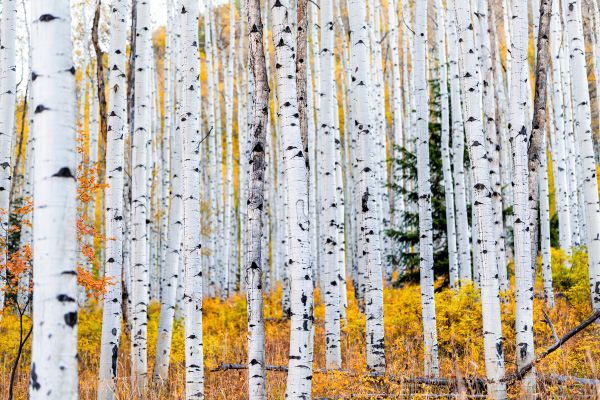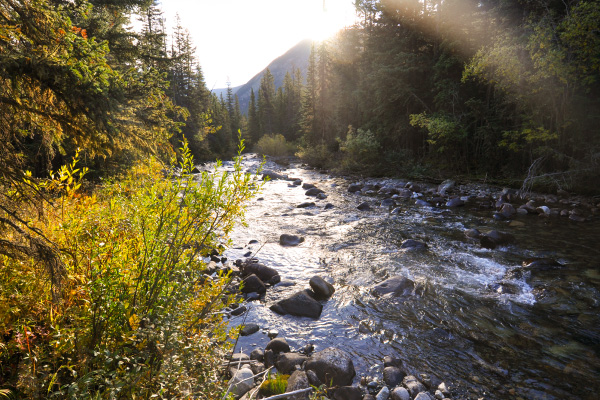 Winter is coming and the forest is preparing in a bright and beautiful way! Colorado winters are notorious for freezing temperatures and heavy snowfall. Luckily, trees have special strategies to protect themselves against these harsh winter conditions, some of which contribute to the colorful backdrop of fall here in Eagle Valley. Evergreen trees such as pine, spruce, and fir have foliage that is well adapted for winter. Their needle-like leaves are covered in a heavy wax coating and the fluid inside their cells resists freezing. Deciduous trees, however, have thinner and more vulnerable leaves. The fluid in the cells of deciduous leaves contains a watery sap which freezes easily. For this reason, deciduous tree species have adapted to lose their leaves during the fall in preparation for the cold winter months ahead. Aspens are the most abundant deciduous tree here in Colorado. Before aspens lose their leaves entirely, they put on quite the color show. Let's explore the science behind aspens in autumn and the beautiful colors of fall!
Winter is coming and the forest is preparing in a bright and beautiful way! Colorado winters are notorious for freezing temperatures and heavy snowfall. Luckily, trees have special strategies to protect themselves against these harsh winter conditions, some of which contribute to the colorful backdrop of fall here in Eagle Valley. Evergreen trees such as pine, spruce, and fir have foliage that is well adapted for winter. Their needle-like leaves are covered in a heavy wax coating and the fluid inside their cells resists freezing. Deciduous trees, however, have thinner and more vulnerable leaves. The fluid in the cells of deciduous leaves contains a watery sap which freezes easily. For this reason, deciduous tree species have adapted to lose their leaves during the fall in preparation for the cold winter months ahead. Aspens are the most abundant deciduous tree here in Colorado. Before aspens lose their leaves entirely, they put on quite the color show. Let's explore the science behind aspens in autumn and the beautiful colors of fall!
During the sunny spring and summer months, aspen leaves appear green due to chlorophyll. Chlorophyll is an amazing chemical that allows plants to make energy from sunlight through a process called photosynthesis. As the days begin to get shorter in the fall, trees will detect the difference in light availability. This triggers them into winter preparation mode. Production of chlorophyll slows down. Without green chlorophyll stealing the show, other chemicals called carotenoids and anthocyanins within the leaf start to take center stage. Carotenoids are yellow, orange and brown pigments within the tree’s leaves. They can also be found in fruits, vegetables and flowers such as corn, carrots, bananas and buttercups. Anthocyanins are the pigment that adds red and purple to our fall color palette. It is also responsible for the red hues in cranberries, concord grapes, blueberries, cherries and plums, just to name a few.
The weather that occurs before and during the early autumn can influence the intensity and timing of fall colors. Carotenoids are always present in leaves, so colors of yellow and orange remain consistent from year to year. Warm sunny days followed by cool nights above freezing is thought to trigger colors of deep intensity within deciduous tree communities. This weather combination increases the production of anthocyanin, which can add to the variety and depth of red foliage coloration we see each season. As yellows, oranges and reds spread throughout the forest canopy, trees prepare to part ways with their leaves. Nutrient flow begins to slow, and the point at which each leaf attaches to its branch undergoes a change. The tree creates a special layer of cells that gradually severs its tissues supporting each leaf. The colorful but weakened leaves will eventually fall to the forest floor, sometimes by means of their own weight or by way of wind, rain or snow.
As yellows, oranges and reds spread throughout the forest canopy, trees prepare to part ways with their leaves. Nutrient flow begins to slow, and the point at which each leaf attaches to its branch undergoes a change. The tree creates a special layer of cells that gradually severs its tissues supporting each leaf. The colorful but weakened leaves will eventually fall to the forest floor, sometimes by means of their own weight or by way of wind, rain or snow.
Fall is a beautiful, but fleeting time of year. Make sure to go outside and enjoy it while it's here!
Sources:
https://www.fs.usda.gov/visit/fall-colors/science-of-fall-colors
https://www.nps.gov/romo/planyourvisit/upload/aspen_beauty_2009.pdf
https://www.esf.edu/pubprog/brochure/leaves/leaves.htm
https://csfs.colostate.edu/aspen-fall-colors/
https://scijinks.gov/leaves-color/Sarah Noyes is a Naturalist at Walking Mountains Science Center. You can find her frolicing in the fall foliage, or quietly sitting on the banks of the Vail beaver pond. Join Sarah or another Naturalist for a free guided Fall Nature Walk 2-3pm everyday at Walking Mountains Science Center, or 11-12pm Monday-Saturday at the Vail Nature Center.









